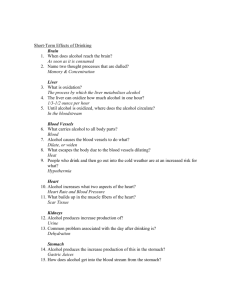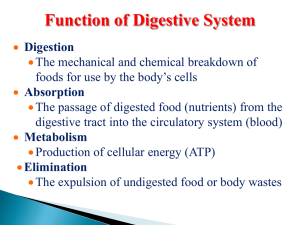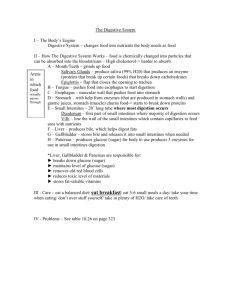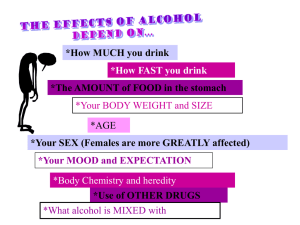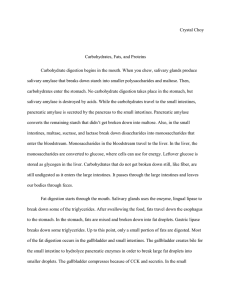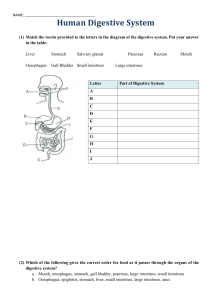Digestion of Alcohol
advertisement
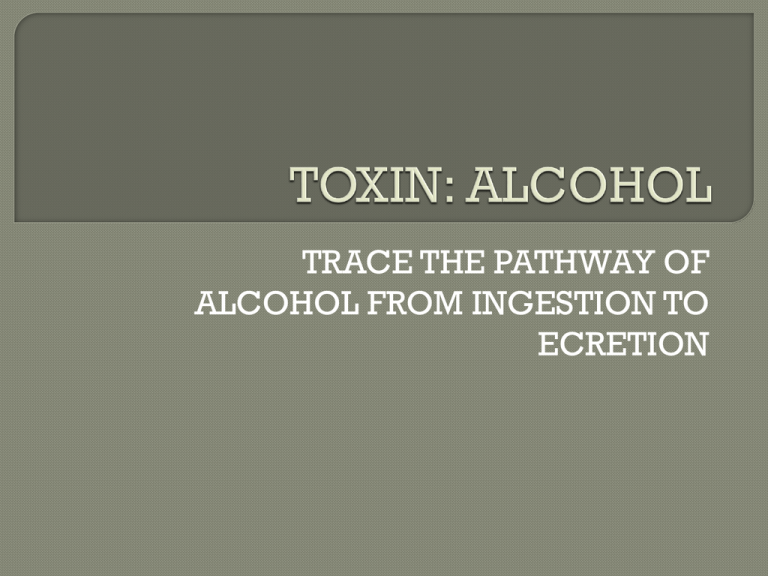
TRACE THE PATHWAY OF ALCOHOL FROM INGESTION TO ECRETION Where does alcohol go once it enters your body? How does your body process/digest alcohol? What organs are involved in processing alcohol? How is alcohol removed from the body? What body system does alcohol affect where the results are quickly visible to others? • Nervous System How did the alcohol get into the nervous system? • Blood transportation How did alcohol get into the blood? • Absorption/digestion by the stomach and other digestive organs How was the alcohol absorbed into the blood? • Diffusion, active transport, osmosis properties What is equilibrium? • A term used from the cellular level to the whole body (ability to balance). “Equal status” Does the concept of equilibrium have anything to do with this process? • Yes, cells are constantly seeking a state of equilibrium where everything within and outside the cell are perfectly balanced. Because this doesn’t happen, cells continue their processes of diffusion, osmosis and active transport which allow our body systems to function. We can received energy from food and eliminate wastes. Why does alcohol affect the CNS? • Some drugs mimic or block the molecules involved in communication between cells and therefore affect operations of the brain and body. The rate at which alcohol enters the bloodstream is dependent on the amount of alcohol consumed, the concentration of alcohol in the beverage, the type of drink, how quickly it was consumed, body weight of person consuming it, and whether the stomach is full or empty. http://www.alcoholmonitoring.com/static /videos/product/howdoes.html?keepThis=true&TB_iframe=tru e&height=525&width=640 1. Mouth 2. Stomach • a. Needs no digestion; alcohol will just absorb into the bloodstream through the stomach lining. • b. 20% of alcohol absorbed in stomach • c. Dependent on the amount of food in stomach and the amount and rate at which the alcohol is ingested. 3. Small Intestines • a. Absorption in upper portion through the walls of the small intestines into the bloodstream. • b. 80% of alcohol absorbed in small intestines. 4. Heart • a. Pumps blood throughout the body with alcohol in it. • b. Goes to the brain and causes CNS responses. 1. Liver • a. Detoxifies (oxidation) the alcohol at a rate of 0.5 ounces (15 ml) an hour. • b. Responsible for eliminating 90% of alcohol ingested. • c. Alcohol is changed first into acetaldehyde (a poison), then to acetic acid and finally into water, carbon dioxide and energy. Liver: (1). If more alcohol arrives than can be broken down the alcohol will travel to all parts of the body, through the blood-stream, and affect various organs of the body. (2). The byproduct of detoxification of alcohol is fatty acids. Fatty acids clog the liver and kill liver cells. This leads to permanent liver damage. • (3). Blood alcohol content (BAC) increase when the body absorbs alcohol faster than it eliminates it. 2. Lungs • a. Expel alcohol through the process of exhalation. • b. Accounts for 1-5% of excretion of alcohol. 3. Kidneys • a. Excretes alcohol through the urine. • b. Accounts for up to 10% of excretion of alcohol. 4. Skin • a. Excretes alcohol through sweat. • b. Accounts for <.5% of excretion of alcohol.



